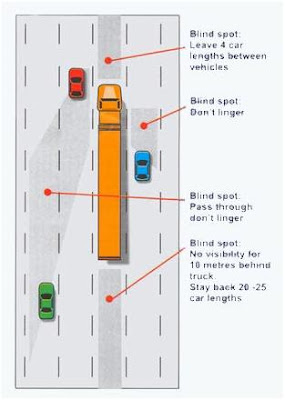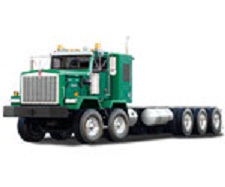I have posted this before and I'll post it again and again and again .... I see so many stupid moves during my commute every morning, I'm not sure what some drivers think they're dealing with when it comes to big rigs.
Anyway ..... below is a post about trucks and blind spots. Truckers already know this, but I hope this'll reach a few more 4-wheel driving individuals each time I post it.
###############################################
I want to dedicate a lot of this blog space to traffic safety when it comes to cars & big rigs.
75% of all car-big rig accidents are caused by the driver of the car, not the truck driver and that’s a stat I believe.
I commute a lot. I drive about 35 miles each way to and from work, 5 days a week, and boy do I see some stupid driving, especially when it comes to small cars vs. semis. (And mind you, ALL cars are small compared to big rigs….)
In this post, I want to write about blind spots.
Blind Spots.
All cars have them. There is nothing as scary as readying yourself to change lanes, you think that the lane next to you is wide open and then all of a sudden you spot a sucker that has been lurking in your blind spot for the past few minutes. It’s enough to give a person a heart attack.
On a regular car, the blind spots are few & they are small. We also have the luxury of being able to turn our heads and look over our shoulder before we merge, to make sure nobody is riding in our blind spot. A truck driver can’t do that. If he turns his head and looks over his shoulder, he’ll see the back of his cab!
A big rig has a lot of blind spots, and some of these blind spots do in fact span across several freeway lanes. Let’s go through them.
1. Front of the Truck: This blind spot ranges out about 20 feet ahead of the semi. The driver won’t see you there. Merging in this close to a big rig can be fatal. Make sure you leave about 4 car lengths between your car and the big rig.
2. Rear of the Truck: About 30 feet directly behind the trailer and you should keep a distance of 25 car lengths. The problem is that when you drive behind a big rig, you can’t see what is going on ahead of you in traffic. You can only trust that the brake lights on the rig in front of you are working properly and that the truck driver is able to hit his brakes in time should something cause a sudden stop. If you are driving too close to the rear end of a big rig and a sudden stop happens, it too could be fatal.I suppose that if you are driving behind a big rig, which sometimes happens, especially on busy freeways, you should drive at a speed that will allow you to stop in time should a sudden stop occur.
3. Left Side of the Truck: a 3-lane span, starting at the end of the truck cab and running down the entire length of the truck. Passing on the left side of a big rig is the correct thing to do, however don’t linger. Make your passing a quick one so that you will be visible again to the driver as fast as possible.
4. Right Side of the Truck: Some trucks have a sticker on the back that says:
<< LEFT - Pass ********* RIGHT – Suicide >>
This sticker isn’t for comedy or posted as a joke. Passing a big rig on the right had side could very well be the last thing you do in life. I don’t mean to be morbid, but that’s a fact. The blind spot on the right hand side of a big rig also fans out for about 3 lanes and runs the length of the truck, but this blind spot is a lot less forgiving than the one on the left.The truck driver may very well see you when you enter the blin
 d spot, but if you linger there and he no longer sees you, he could forget that you are there. If by any chance he has to make a sudden swerve to avoid a collision or an object in the lane, there is no chance he remember that you are still next to him if he can’t see you.
d spot, but if you linger there and he no longer sees you, he could forget that you are there. If by any chance he has to make a sudden swerve to avoid a collision or an object in the lane, there is no chance he remember that you are still next to him if he can’t see you.I bring up the word “fatal” a lot because if you end up in an accident vs a big rig, the chances of you walking away could be minimal. I read somewhere that 78% of small cars vs big rig accidents end in fatality. 78%! And these small cars are the ones I constantly see darting in and out of traffic, passing on the right, passing on the left, cutting off big rigs left and right (and everyone else for that matter). Seriously. You may think you’re the best driver in the world but be cautious when passing big trucks. Unpredictable incidents in the roadway happen a lot, and you want to be visible to a truck driver at all times so that if he does have to make a sudden move, he knows you’re there!
So…blind spots. We all hate them. I’m sure truck drivers despise them. But they’re there. Just be aware of them. And don’t pass on the right!




























